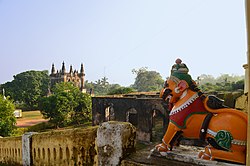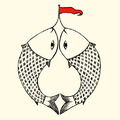History
Foundation of Dhenkanal District
In 1530 CE, Dhenkanal is reported to have been a local tribal kingdom under the rule of Sabara. A campaign was launched by Harisingh Vidyadhara, commander and minister of the Gajapati Maharaja Prataparudra Deva, to bring it under the umbrage of the larger kingdom. Harisingh belonged to the Bhoi dynasty, whose brother Govinda Vidyadhara would later overthrow Prataparudra Deva's successors to become the Gajapati ruler of Odisha. Dhenkanal, situated 150 km north of Puri, was conquered by the Vidyadhara using a force of cavalry and foot soldiers in a battle between the Gajapati's army and the ruling chief. Vidyadhara was then appointed by Gajapati Maharaja as the Raja of Dhenkanal, becoming its hereditary ruler. The conquest brought the remote area under the control of the Gajapati Kingdom and strengthened it against further attacks. This laid the foundation of the Bhoi dynasty branch at Dhenkanal. [1] [2]
In the 18th century, the kingdom withstood the attack by the Maratha forces during the reign of Trilochana Deva. [3] The events of the Maratha-Dhenakanal war of 1781 was also recorded in the ballad Samara Taranga by Brajanath Badajena. Raja Bhagirathi Pratap was a very popular and effective ruler, who was decorated with hereditary title of Mahindra Bahadur.
20th century
Raja Sri Sura Pratap Singh Deo Mahindra Bahadur's eldest son, Prince Shankar Pratap, became Raja in the year 1926. He was young and still studying. Subsequently, he went to England to study Bar at Law. After his return to Dhenkanal, he put his mind to administration.
While Raja Sri Shankar Pratap Singh Deo Mahindra Bahadur was in England, his younger brother, Pattayat Nrusingha Pratap Singh Deo was ruling over Dhenkanal. He built his 100-room palace at Jatan Nagar with forced labour. [4] The labourers were tortured badly. Raja's Accountant also extracted money from common men. After all these incidents people expected an improved state of affairs after Raja Sri Shankar Pratap would return from abroad and take over administration from his younger brother.
Revolt
The revolt was organised and mobilized mainly by Harmohan Patnaik, who was the grandson of Dhenkanal Bebarta Jagannath Patnaik and Dewan Damodar Patnaik. Harmohan Patnaik formed the Dhenkanal Praja Mandal and was elected as its president. This was the first Praja Mandal [5] of British India and then Praja Mandals sprang up in all princely states of India as public organizations to resist the practices of the then Rajas and Maharajas.
The Indian Imperial Police was mobilized by Raja Saheb to repress a revolt. A young boy named Baji Rout refused to ferry police officers using his boat. [6] The police then opened fire and killed Baji Rout and five villagers. This incident inflamed the nearby villagers and the revolt spread to the entire Dhenkanal State.
The Praja Mandal movement mobilized mass gatherings and a charter of rights was drawn. During the years of struggle, the Indian National Congress also became associated with the Dhenkanal movement. Arrests and imprisonments were a regular occurrence. Whenever Raja Saheb's forces imprisoned Harmohan Patnaik, the people surrounded the Palace in great numbers. Raja Saheb felt threatened and released Harmohan Patnaik unconditionally.
Independence of India
The independence of India in the year 1947 put a stop to the unrest. Raja Sri Shankar Pratap Singh Deo Mahindra Bahadur accepted Harmohan Patnaik as an adviser. Subsequently, princely states were taken over and Rajas and Maharajas were deposed. Raja Sri Shankar Pratap was elected as Member of newly formed Odisha Legislative Assembly. Ranee Smt. Ratna Prabha Devi was an M.L.A. for two terms. Raja Sri Shankar Pratap's son, Brigadier Kamakhya Prasad Singh Deo, became a Member of Indian Parliament and a Minister in the Government of India's cabinet. He was the President of Orissa Pradesh Congress Committee.
This page is based on this
Wikipedia article Text is available under the
CC BY-SA 4.0 license; additional terms may apply.
Images, videos and audio are available under their respective licenses.



